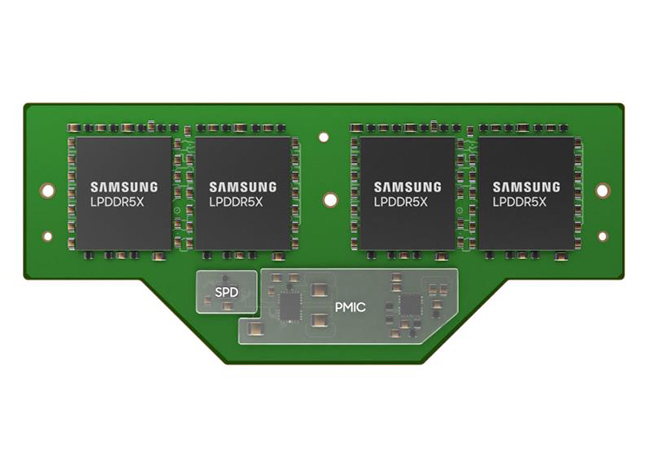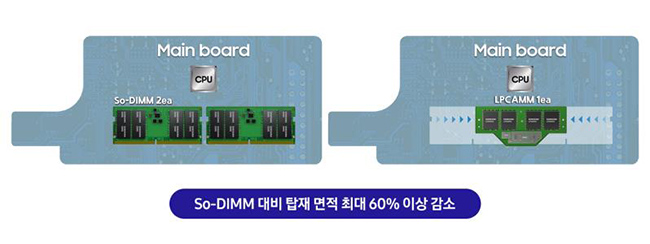
Samsung Electronics has achieved a groundbreaking milestone by successfully developing a Low Power Compression Attached Memory Module (LPCAMM), a next-generation memory solution based on low-consumption DRAM technology. (Image courtesy of Yonhap)
SEOUL, Sept. 27 (Korea Bizwire) – Samsung Electronics has achieved a groundbreaking milestone by successfully developing a Low Power Compression Attached Memory Module (LPCAMM), a next-generation memory solution based on low-consumption DRAM technology. This achievement is poised to reshape the landscape of the next-generation PC market, including notebooks and mini-PCs, due to its remarkable potential for product miniaturization.
In an official announcement made on Tuesday, Samsung Electronics unveiled its LPCAMM memory, boasting an impressive data transfer rate of 7.5 gigabits per second (Gbps) built on LPDDR DRAM. Samsung Electronics has rigorously tested the product’s functionality on Intel’s platform and intends to further validate it within next-generation systems alongside key partners, including Intel, with the aim of commercializing the technology in 2024.
The LPCAMM is grounded in the principles of low-consumption DRAM (LPDDR) packaging and adheres to the CAMM standard—a cutting-edge memory module framework introduced by the Joint Electron Devices Engineering Committee (JEDEC). This standard optimizes internal space utilization, resulting in a more compact product profile.
Notably, LPCAMM has ushered in a wave of technological innovations, excelling in performance, power efficiency, and design efficiency when compared to the SODIMM (Small Outline Dual In-line Memory Module) standard, which has dominated small devices for the past decade.

LPCAMMs offer an astounding reduction in footprint, exceeding 60 percent when compared to SODIMMs. (Image courtesy of Yonhap)
LPCAMMs offer an astounding reduction in footprint, exceeding 60 percent when compared to SODIMMs. This provides greater flexibility in configuring components for PCs and laptops, offering the potential for enhanced battery capacity. Power efficiency is also dramatically improved, with potential gains of up to 70 percent, significantly enhancing the energy efficiency of small devices—an essential factor in product competitiveness.
Samsung Electronics anticipates that LPCAMM will introduce a new form factor paradigm to the next-generation PC and notebook market. Furthermore, it has achieved a remarkable performance boost of up to 50 percent compared to SODIMMs.
In today’s data-centric world, data center customers are increasingly exploring high-performance, low-consumption DRAM solutions to enhance their total cost of ownership (TCO). This trend is expected to extend into applications like artificial intelligence (AI), high-performance computing (HPC), servers, and data centers.
LPCAMM also enhances the convenience of product usage, replacement, and upgrades. Traditionally, PCs and laptops have employed the on-board installation of LPDDR packaged products directly onto the mainboard. While this approach offers advantages in terms of miniaturization and power efficiency, it poses challenges when upgrading performance specifications or addressing issues, often necessitating the replacement of the entire mainboard.
Furthermore, the existing SODIMM standard, while detachable, has been criticized for its limitations in physical development, including space inefficiency, due to the transmission speed and form of attaching DRAM to both sides of the board. In contrast, LPCAMM’s removable design and reduced volume make it ideal for server applications, enabling cost-effective upgrades based on desired performance levels and delivering power efficiency gains in operational costs.
Kevin Lee (kevinlee@koreabizwire.com)






